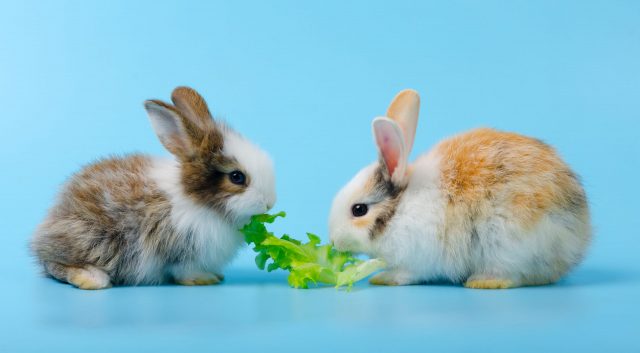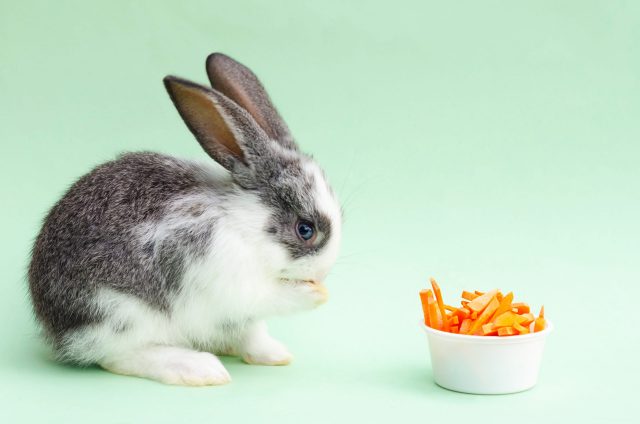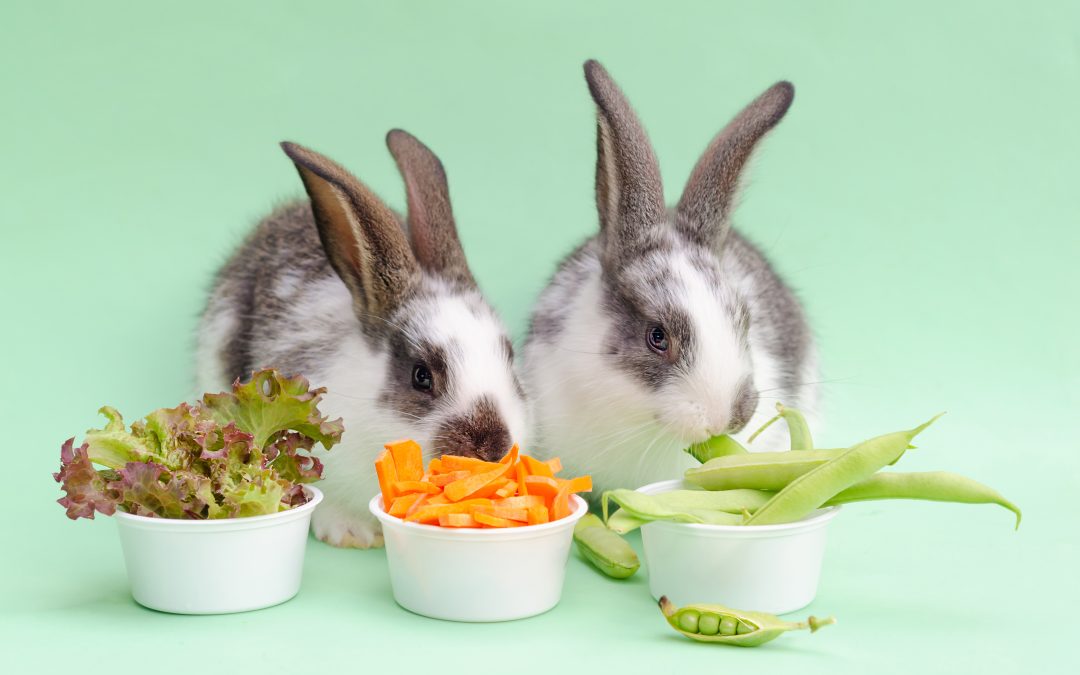A lot of people naturally associate rabbits with carrots. After all, we’ve all seen the cartoons of Bugs Bunny with a carrot dangling from his mouth.
It’s true that most house rabbits love carrots and will delightedly gobble up as many as they can get, but the fact is carrots are meant to be a treat, not a main staple of the house rabbit diet.
The house rabbit’s ideal diet consists of three main staples: hay, pellets, and vegetables. Knowing what and how much to feed your rabbit will play an important role in her health throughout her life. If you have questions about your rabbit’s diet, talk with an experienced rabbit vet.

Two adorable fluffy bunnies rabbits eating green lettuce vegetable together
Hay
One of the staples of the bunny diet is fresh hay – house rabbits should always have a generous supply of hay for them to munch on throughout the day. Young bunnies, six months and under, should eat plenty of alfalfa hay.
Because alfalfa is high in calories and rich in calcium, when a bunny turns seven months old, she should be weaned off of the alfalfa and started on timothy hay, oat hay, or grass hay.
Some bunny owners purchase hay for their bunnies at local farms, while others prefer using companies like Oxbow and Sweet Meadow. Regardless of the brand of hay, always make sure the hay is fresh. Dust is a sign that hay is bad, so if you get a batch of dusty hay, be sure to get rid of it and purchase fresh hay.
Pellets
There are two schools of thought when it comes to feeding house rabbits pellets. One side believes it is okay to feed high-quality pellets in moderation, while the other side believes that pellets should not be part of a healthy rabbit’s diet. If you opt not to feed your house rabbit pellets, you must add more vegetables to her diet.
There is one exception to the rule, no matter which school of thought you subscribe to:
Until bunnies reach seven months old, they should be given unlimited pellets, along with their unlimited alfalfa hay.
Once your rabbit reaches seven months and until she hits a year, begin to feed her a half a cup of pellets per six pounds of body weight.
Rabbits between one and five years should get between a quarter of a cup and a half of a cup of pellets, per six pounds of body weight, per day. Those rabbits six and older, considered seniors, may be allowed to have unlimited pellets again if their weight has dropped. However, before you start offering your senior bun unlimited pellets, consult with your vet.
If you choose to give your house rabbit pellets, make sure you choose a pellet that contains at least 18 percent fiber. Always feed your rabbit fresh pellets. The House Rabbit Society suggests buying only a six-week supply of pellets at a time, as they become stale quickly.

A little baby bunny rabbit eating carrots.
Vegetables
Vegetables are an important part of a rabbit’s daily diet. Rabbits should not be introduced to vegetables until they are at least 12 weeks of age. At that point, the young bunny should be introduced to one vegetable at a time, and each serving should be no more than half an ounce.
Once a rabbit hits seven months, you can start giving her more vegetables. Experts recommend no less than two cups of vegetables (chopped) a day per six pounds for rabbits between a year and five years.
Always introduce one new vegetable to your rabbit at a time. If a particular vegetable causes your rabbit to have diarrhea or soft stools, simply take that vegetable out of your rabbit’s diet.
Those vegetables that are good for house rabbits, according to the House Rabbit Society, include alfalfa, radish, clover sprouts, basil, the tops of beet greens, bok choy, broccoli,
Brussels sprouts, carrots, carrot tops, celery, cilantro, clover, collar greens, dandelion greens, dandelion flowers, endive, escarole, green peppers, kale, mint, mustard greens, parsley, peppermint leaves, radicchio, radish tops, raspberry leaves, romaine lettuce, green leaf lettuce, spinach, watercress, and wheatgrass.
If you feed your bunny vegetables – like dandelion greens and the dandelion flower – from your backyard or garden, make sure they are pesticide-free.
Treats for Your Pet Rabbits
Most animals love treats, and house rabbits are certainly no exception. Carrots, apples, and bananas are some bunny favorites. But, all treats must be given in moderation.
Fruits like carrots, apples, and bananas are high in sugar and, even though your bunny will eat as many as she can, the result can be an upset stomach or a bout of the dangerous condition G.I. stasis.

